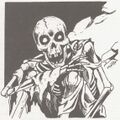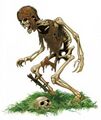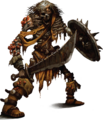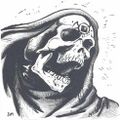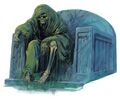Skeleton
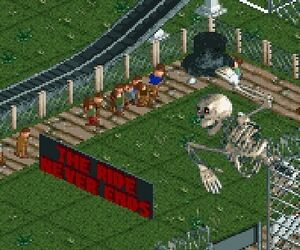
- – Andrew Gold
A skeleton is a rigid supporting structure. It usually assumes the context of supporting a living creature, either from the inside (an endoskeleton) or the outside (an exoskeleton), but the term is also used figuratively to refer to the supporting structure of a non-living thing (e.g. the skeleton of a building). You might not realize it, but there is a skeleton inside you!
Because they are hard and made of inorganic calcium and other minerals, they tend to persist after the death of their organism -- potentially for millions of years, if conditions are right. Because of this, they are often identified with death; in fact, the word skeleton comes from the Greek word for "mummy" or "dried body". Grim Reapers and other personifications of death tend to be skeletons, or at least have skulls for heads, and skeletons in general are spooky and scary to most people.
Skeletons are also a favorite choice of minion for necromancers -- they have no flesh, which means they don't rot or smell bad, and makes them slightly more resilient to slashing damage (though hammers are quite effective, and as undead, holy damage is also a good choice; some paladins call them 'hammer fodder' for this very reason). They also tend to be just as fast as they were in life, unlike the shambling zombies, making them useful for time-critical tasks as well as fast-paced combat. Additionally, skeletons are just smart enough to wield weapons, normally the ones they used in life.
Not all skeletons are of humanoids. Animal skeletons are better combat minons and make tireless beasts of burden. The necromancy-focused armies of Eberron's Karrnath often employ skeleton horses which, in addition to being tireless, are a stable enough ride to rest in the saddle of. Dragon skeletons are popular thematically since they are so long lived and tough that it can convey just how old a location is or how tough whatever killed them was. Player accessible necromancy options rarely support undead dragons well however.
One particularly disturbing version of skeletons is the exoskeleton of insects, arachnids, and crustaceans (among others). While on most creatures the skeleton is inside, an exoskeleton is on the outside. These can be reanimated by necromancers as well and are more difficult to distinguish from the living version. Beware a Swarm of exoskeleton bugs.
Liches are sometimes depicted as skeletons, and sometimes more as desiccated zombies or mummies, depending on the art. Dracoliches however, are almost always skeletons.
A final word of warning, skeletons tend to be unpredictable; they are equally likely to make lame bone-based puns, violently disembowel you, or show up to your concert because you opted to buy a xylophone instead of a marimba.
D&D Skeleton Variants
In AD&D, the following skeletons existed:
- Common Skeleton: The calcium-rich spookybois we all know and love.
-
1e
-
2e
-
3e
-
4e
-
5e
- Skeleton Warrior: An upgraded skeleton with its soul trapped in a golden circlet.
- Archer Skeleton: A skeleton unique to Ravenloft that is created by magically fusing a bloody arrowhead into their skull during reanimation.
- Giant Skeleton (renamed Pyroskeleton in 3e): According to the lore, they are not the remains of giants, but regular skeletons that have been magically enlarged. Also, their chest cavities are perpetually on fire for seemingly no reason other than to give them a fireball attack. This is explained as an unavoidable side effect of the magic used to create them.
- Blazing Bones: If a spellcaster has a contingency spell prepared to prevent their own death and is killed by fire damage, they are resurrected as a flaming skeleton which is eternally feeling the pain of being on fire and can only lessen it by setting other people on fire.
- Burnbones: A lot like blazing bones except they are all clerics of Cyric that he transformed so that they could better fight the forces of Bane. Needless to say, these are unique to the Forgotten Realms.
- Crimson Bones: Ravenloft variant that is too stupid to use weapons but is perpetually dripping poisonous blood. They are created from people who got flayed alive by Shadow Fey.
- Bonebat: Skeletal bat with a paralyzing bite.
- Crypt Thing: A fairly unimaginative undead that appears as a skeleton wearing a robe. It's job is to protect its crypt from grave robbers. It does this by teleporting adversaries to a random spot up to 1000 feet away.
- Baneguard: Skeletons animated by priests of Bane to serve as guards (go figure). Not necessarily humanoid. The more powerful versions are called Direguards.
Gallery
-
Sometimes a skeleton just wants to have some fun.
-
Skeletons are not only inside humans, but other nightmarish species as well.
See Also
- Deep Rot, a skeleton-based computer constructed by a necromancer with a penchant for mad science.
- Spooky Skeletons vs Sickass Demons, a FATE scenario that a fa/tg/uy wrote in honor of this meme


